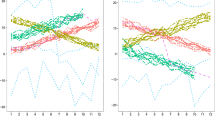Abstract
Time series clustering is an effective vehicle to explore and visualize the structure of a suite of time series. In this study, we generalize the kernel-based fuzzy c-means clustering algorithm by involving the dynamic time alignment kernel (DTAK) to cluster vector time series. In this method, the nonlinear time alignment embedded in DTAK makes the kernel-based fuzzy c-means available for sequences with variable lengths. However, it is noted that DTAK is not a strictly positive definite kernel, especially when the sample size is large. To overcome this, some strategies are presented to make the proposed algorithm available for large data sets. In addition, it is a challenge task to calculate the average sequence for a series of time series with different lengths. In kernel-based fuzzy c-means algorithm, it is not necessary to calculate the average sequence, which will increase the effectiveness of clustering techniques for time series. In the experiments, the kernel-based fuzzy c-means with DTAK is evaluated by both the data sets from the UCI KDD Archive and real-world data sets. Experimental results delivered by the proposed method demonstrate its effectiveness and robustness.












Similar content being viewed by others
References
Aghabozorgi S, Shirkhorshidi AS, Wah TY (2015) Time-series clustering—a decade review. Inf Syst 53(C):16–38
Chen TY, Kuo FC, Merkel R (2004) On the statistical properties of the f-measure. In: Quality software, 2004. QSIC 2004. In: Proceedings of fourth international conference on, IEEE, pp 146–153
Cuturi M, Vert JP, Birkenes O, Matsui T (2006) A kernel for time series based on global alignments. In: IEEE international conference on acoustics, speech and signal processing, pp II-413–II-416
Dhillon IS, Guan Y, Kulis B (2004) Kernel k-means: spectral clustering and normalized cuts. In: Proceedings of the tenth ACM SIGKDD international conference on Knowledge discovery and data mining, ACM, pp 551–556
Dua D, Graff C (2017) UCI machine learning repository. http://archive.ics.uci.edu/ml
Everitt B, Landau S, Leese M (2001) Cluster analysis, 4th edn. Arnold, Paris
Graves D, Pedrycz W (2010) Kernel-based fuzzy clustering and fuzzy clustering: a comparative experimental study 161(4):522–543
Haasdonk B (2005) Feature space interpretation of svms with indefinite kernels. IEEE Trans Pattern Anal Mach Intell 27(4):482
Izakian Z, Mesgari MS, Abraham A (2016) Automated clustering of trajectory data using a particle swarm optimization. Comput Environ Urban Syst 55:55–65
Ketterlin A (2011) A global averaging method for dynamic time warping, with applications to clustering. Elsevier Science Inc, New York
Muller KR, Mika S (2001) An introduction to kernel-based learning algorithms. IEEE Trans Neural Netw 12(2):181–201
Li AZ, Tang S, Xue J, Jiang J (2001) Modified FCM clustering based on kernel mapping. In: Proceedings of SPIE, pp 241–245
Liao TW (2005) Clustering of time series data—a survey. Pattern Recogn 38(11):1857–1874
Niennattrakul V, Srisai D, Ratanamahatana CA (2012) Shape-based template matching for time series data. Knowl-Based Syst 26:1–8
Noma HSK, Shimodaira K (2002) Dynamic time-alignment kernel in support vector machine. Adv Neural Inf Process Syst 14:921
Sakoe H, Chiba S (1971) A dynamic programming approach to continuous speech recognition. In: Proceedings of the 7th international congress on acoustics, pp 65–69
Sakoe H, Chiba S (1978) Dynamic programming algorithm optimization for spoken word recognition. IEEE Trans Acoust Speech Signal Process 26(1):43–49
Santarcangelo J, Zhang XP (2015) Dynamic time-alignment k-means kernel clustering for time sequence clustering. In: IEEE international conference on image processing, pp 2532–2536
Saxena A, Prasad M, Gupta A, Bharill N, Patel OP, Tiwari A, Meng JE, Ding W, Lin CT (2017) A review of clustering techniques and developments. Neurocomputing 2017:267
Shimodaira H, Noma KI, Nakai M, Sagayama S (2001) Dynamic time-alignment kernel in support vector machine. In: International conference on neural information processing systems: natural and synthetic, pp 921–928
Wang X, Ma KT, Ng GW, Grimson WEL (2008) Trajectory analysis and semantic region modeling using a nonparametric Bayesian model. In: Computer vision and pattern recognition, 2008. CVPR 2008. IEEE conference on, pp 1–8
Xu R, Ii DCW (2005) IEEE, survey of clustering algorithms. IEEE Trans Neural Netw 16(3):645–678
Yi BK, Jagadish H, Faloutsos C (1998) Efficient retrieval of similar time sequences under time warping. In: Data engineering, 1998. Proceedings of 14th international conference on, IEEE, pp 201–208
Zha H, He X, Ding C, Gu M, Simon HD (2001) Spectral relaxation for k-means clustering. In: Advances in neural information processing systems, pp 1057–1064
Zhang DQ, Chen SC (2003) Fuzzy clustering using kernel method. In: International conference on control and automation, 2002. ICCA. Final program and book of, pp 162–163
Zhou F, De la Torre F, Hodgins JK (2013) Hierarchical aligned cluster analysis for temporal clustering of human motion. Pattern Anal Mach Intell IEEE Trans 35(3):582–596
Zhou S, Gan JQ (2004) Mercer kernel, fuzzy c-means algorithm, and prototypes of clusters, vol 3177, pp 613–618
Acknowledgements
This work is supported by the Natural Science Foundation of China under Grant 71831002, 61773352, Program for Innovative Research Team in University of Ministry of Education of China IRT_17R13, the Postdoctoral Science Foundation of China under Grant 2019M651100, the Natural Science Foundation of Liaoning Province 2019-BS-029, the Scocial Science Foundation of Liaoning Province L18DGL010, and the Fundamental Research Funds for the Central Universities 3132019501, 3132019502.
Author information
Authors and Affiliations
Corresponding author
Additional information
Publisher's Note
Springer Nature remains neutral with regard to jurisdictional claims in published maps and institutional affiliations.
Rights and permissions
About this article
Cite this article
Guo, H., Wang, L. & Liu, X. Dynamic time alignment kernel-based fuzzy clustering of non-equal length vector time series. Int. J. Mach. Learn. & Cyber. 10, 3167–3179 (2019). https://doi.org/10.1007/s13042-019-01007-3
Received:
Accepted:
Published:
Issue Date:
DOI: https://doi.org/10.1007/s13042-019-01007-3




